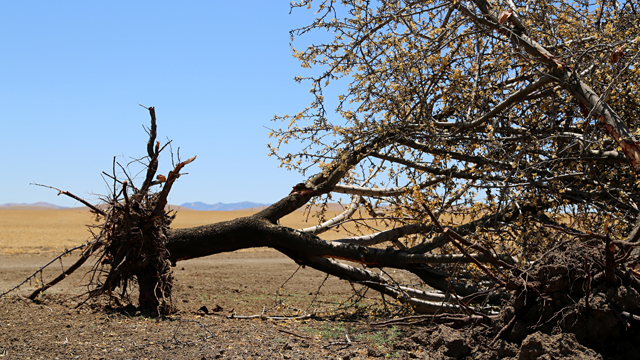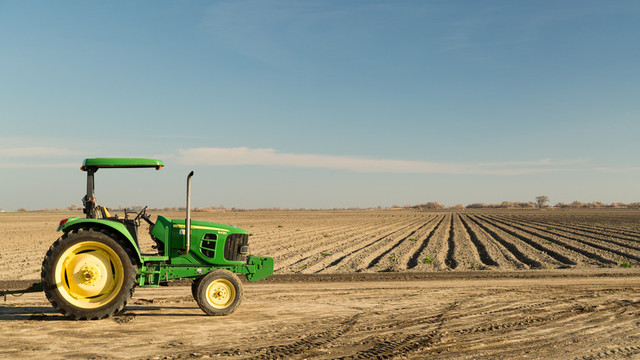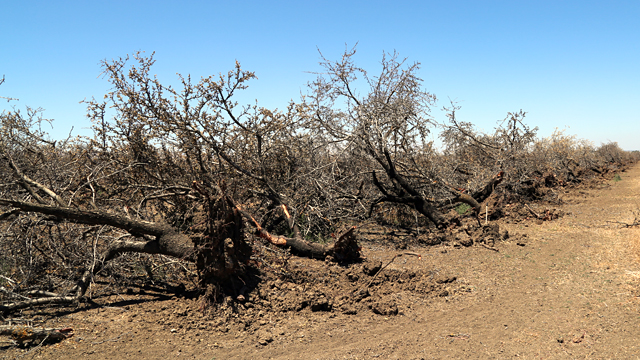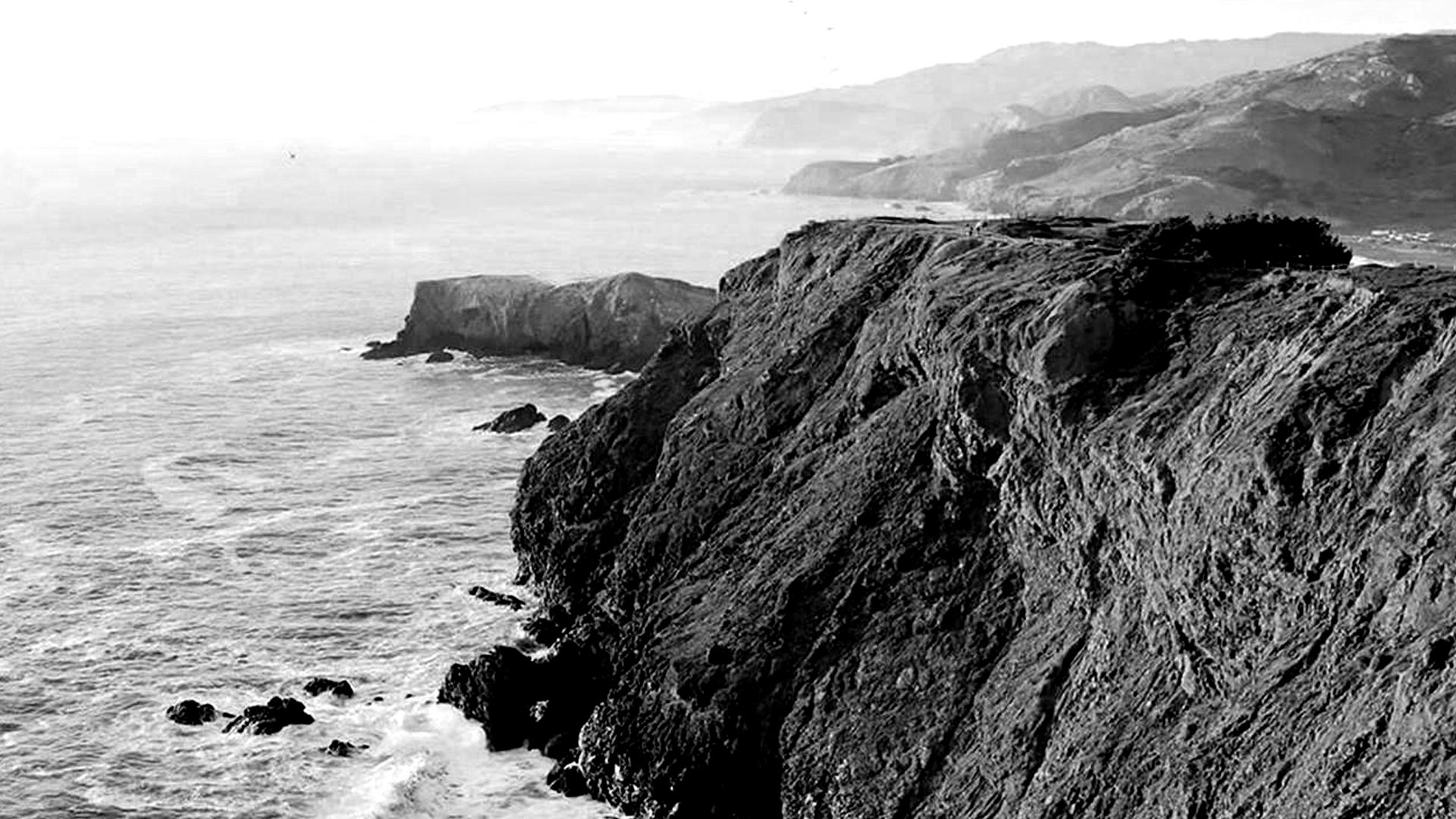As Water Prices Soar, Some Profit From California’s Drought
As Water Prices Soar, Some Profit From California’s Drought

Farmers who lack water in California are facing a tough summer ahead, but for those who do have water, it can be a windfall.
Water is hitting record prices on the open market, prompting some farmers to pump groundwater and sell it — what some call “groundwater mining.” With groundwater already at record-low levels in parts of the state, concerns are rising that these water sales, known as water transfers, may put pressure on California’s overtaxed aquifers.
In other water deals, farmers are selling the water they get from reservoirs or rivers and are using groundwater instead to irrigate their fields, known as “groundwater substitution.”
More than 60 billion gallons of groundwater are being proposed in water sales this year — either sold for profit or substituted for water sold for profit, according to a KQED analysis of documents filed with state and federal agencies.
Drawing the Battle Lines
In May, Anthea Hansen took the podium at a crowded Merced County Board of Supervisors meeting, knowing she was facing a tough crowd.
“I’m sorry to bring this issue to your board and cause such a ruckus,” she said.
Hansen is the general manger of the Del Puerto Water District, which serves about 45,000 acres of farmland on the west side of the San Joaquin Valley, an hour south of Stockton. But here she was, 50 miles away in Merced, telling the board why she needs to buy groundwater to save her district’s crops and orchards.
“We’re in crisis mode,” she said. “I have trees I need to keep alive. We don’t need large quantities of water to do that. If that doesn’t happen, the trees are gone.”
Like many water districts with the lowest-priority rights, “junior” water rights, Del Puerto’s normal water supply has dried up this year. Water levels in the federal reservoir system, known as the Central Valley Project, are too low to meet demand.
So, Hansen worked out a deal with two ranchers in Merced County. They would pump up to seven billion gallons of their groundwater, put it into canals, and sell it to Hansen’s farmers over two years.
“This is common practice,” Steve Sloan told the Merced Board of Supervisors at the same meeting. He’s one of the ranchers who stands to make millions from the deal. Under California’s system of water rights, he owns the groundwater under his property.
“Water exchanges, water transfers have been done for over 30 years,” Sloan said. “This is how we survive collectively as an ag industry in California.”

Some of Sloan’s neighbors don’t see it that way.
“I’m within about a five-mile radius of where they’re going be doing the pumping. So, obviously I’m concerned,” Mike Gallo told the board. Gallo runs a farming operation near Sloan’s. “What’s gonna happen when you take this much water out of an aquifer? We’re on the same aquifer. I don’t know what it’s going to do.”
Billy Grissom, a farmer and cattle rancher who owns property near Sloan’s, also objected to the water sale. “Water underground should not be sold for monetary gain,” Grissom said. “When the water is gone, all the farming is gone.”
“We’re doing extensive monitoring,” Sloan responded. “We don’t want to damage the aquifer. We don’t want to damage our neighbors.”
The Bureau of Reclamation is reviewing the water transfer because the water would move through federal infrastructure. In a preliminary report, the agency found there would be no significant environmental impact, though groundwater levels could be drawn down. While Merced County supervisors are also looking into the water transfer, they have little influence over the deal.
Water Sales as Lifeline
“The water transfer market is the only way we’re surviving right now,” said Lon Martin, assistant general manager of the San Luis Water District, another Central Valley district that has a zero water allocation this year.
Martin is walking among hundreds of uprooted almond trees near Los Banos; the orchard was ripped out because of the drought.
“We hope that we don’t see any more of this,” he said. “Depending on the ability of the water district to bring water supplies — if we’re not successful with that, we may see more orchards taken offline.”
Martin says in a dry year like this one, there are fewer water transfers than usual, but one of the few large deals going through may help the trees in his district.
Nine water districts north of Sacramento are planning to sell 26 billion gallons of water, about as much as San Francisco uses in a year. Farmers would fallow crops or would pump and use groundwater instead, freeing up their water in rivers and making it available for buyers down south.
Ten water districts in the San Joaquin Valley would purchase the water, which is about half as much water as they’d tried to arrange to purchase in the transfer earlier this year. The deal is expected to cost $72 million.
“There are literally people with no water on their account, so this represents the only lifeline they have this year,” said Ara Azhderian, water policy administrator with the San Luis & Delta-Mendota Water Authority, which negotiated the water transfer for the San Joaquin Valley water districts.
Legal Challenge
“California has neglected its groundwater,” says Barbara Vlamis, director of AquAlliance, a non-profit focused on the Sacramento watershed. Her group is suing to stop the water transfer over groundwater concerns.

“You’re putting an added stress on the groundwater basin,” Vlamis said. “In the last year alone, there have been wells in Glenn County that have dropped 32 feet. Nineteen feet in Butte County.”
Vlamis says the problem is that groundwater isn’t regulated in California, so state and federal agencies don’t have a full picture of the impact transfers can have.
“It’s shoddy,” she said. “The agencies that are so casual about moving water out of here need to truly analyze what they’re doing to this region.”
The legal challenge has raised anxiety levels for districts that were counting on purchasing the water.
“It’s a huge cloud of uncertainty,” Azhderian said. “You’ve got growers that not only have their livelihoods and farms at risk, but they have then dipped into stressed financial resources to make this transfer happen.”
Rise of California’s Water Market
“Water transfers are a way of making water available to people that don’t have old, senior water rights,” said Ellen Hanak, senior fellow at the Public Policy Institute of California.
Water transfers in California first emerged during the 1976-77 drought. “The idea was to stretch the available supplies and do the least economic harm,” Hanak said. “It made sense to allow the market signals to work and allow people to lease that water to folks that were able to pay more for it.”
Water transfers have since become commonplace. Earlier this year, Governor Jerry Brown ordered state agencies to speed up their environmental review of water transfers to help with the drought.
As groundwater levels dropped dramatically in the Central Valley, concerns have emerged about any added pressure to pump.
The San Joaquin Valley has experienced the highest levels of groundwater overdraft, but there’s also increased pumping in the Sacramento Valley, generally perceived to have plenty of water.
“You’re seeing an expansion of orchard crops, including in places that did not used to be irrigated,” Hanak said, “and it’s relying on groundwater.”
The concerns over using groundwater in water transfers tie into larger challenges California is facing in monitoring and managing its underground reservoirs, Hanak said.
“The state will look carefully at a transfer to make sure that you aren’t selling water out of a river or lake that someone downstream of you would be using,” she said. “But because California does not have statewide regulation of groundwater, the state doesn’t have the possibility of easily making that assessment about groundwater use.”
Some counties have taken matters into their own hands and have passed rules that effectively ban the sale of groundwater outside county lines. In Merced County, where controversy over the groundwater sale continues, county supervisors have said they’re looking into that policy.
